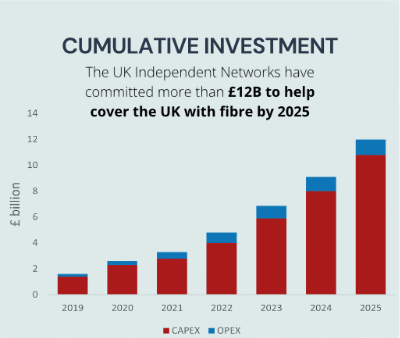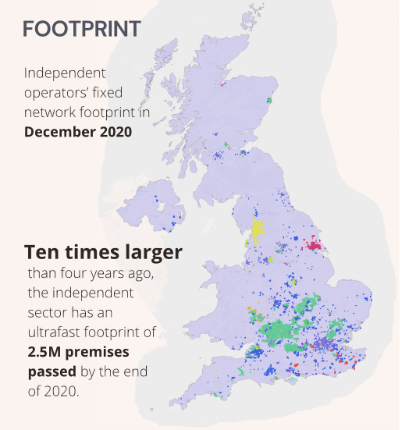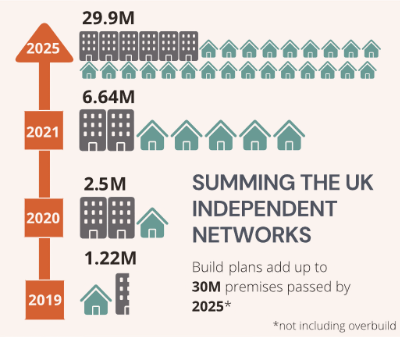Over 2.5m homes and businesses in the UK can now connect to an independent fibre broadband network, according to new figures published today (7 June 2021). This represents over 110 per cent year-on-year growth and confirms the major contribution the ‘altnets’ are making to the Government's target for delivering national coverage of gigabit capable broadband.
Compiled for the Independent Networks Co-operative Association (INCA) by Point Topic using data provided by independent network operators, this years ‘Metrics for the UK Independent Network Sector’ report shows that the sector is four times larger than a decade ago and continues to attract significant sums of private investment. Nearly £12bn will be invested in the delivery of new full fibre connectivity by independent providers before the end of 2025.
 “This report demonstrates that the ‘altnets’ are making a major contribution to meeting the Government’s targets for gigabit broadband connectivity” said Malcolm Corbett, CEO at INCA. “This current wave of investment, particularly in full fibre and wireless broadband networks, means there is no segment of the market where there isn’t a plan to build independent networks. This should be applauded and supported by government, regulator and the wider community”, Mr Corbett continued.
“This report demonstrates that the ‘altnets’ are making a major contribution to meeting the Government’s targets for gigabit broadband connectivity” said Malcolm Corbett, CEO at INCA. “This current wave of investment, particularly in full fibre and wireless broadband networks, means there is no segment of the market where there isn’t a plan to build independent networks. This should be applauded and supported by government, regulator and the wider community”, Mr Corbett continued.
The Point Topic report provides an overview of the UK’s independent network operator sector as of end-2020 and early 2021 in terms of scale, coverage, ambitions and concerns. As in the previous two years it includes both fixed and fixed wireless network operators drawing on input from both INCA members and non-members.
 “Full fibre coverage from the independent sector is significant and accelerating,” commented Point Topic’s CEO, Oliver Johnson. “Conditions in the UK are encouraging for the altnets. Demand and supply are being driven by a renewed consumer appreciation and desire for better downstream and upstream capacity and stability as well as access to more finance and an encouraging regulatory environment”, he said.
“Full fibre coverage from the independent sector is significant and accelerating,” commented Point Topic’s CEO, Oliver Johnson. “Conditions in the UK are encouraging for the altnets. Demand and supply are being driven by a renewed consumer appreciation and desire for better downstream and upstream capacity and stability as well as access to more finance and an encouraging regulatory environment”, he said.
Community broadband provider County Broadband, based in Aldham, Essex, received a £46 million private investment in 2018 from Aviva Investors to build FTTP networks in rural and hard-to-reach premises across the East of England. The independent service provider (ISP), which has just been awarded two Gold Standard Quality Marks from INCA, after marking a seven-fold workforce increase in just three years, is engaging with over 100 villages in its FTTP rollout. Their chief executive, Lloyd Felton, said:
“The accelerating rollout of full-fibre networks is a testament to the hard work of independent ISPs who have led the charge by identifying new market opportunities, lobbying for more training and skills, investment and collaborating to share insight and improve efficiency. FTTP technology has emerged as the clear frontrunner for delivering future-ready speeds and altnets have raised significant capital from enthusiastic investors. The focus now must be on removing barriers so these complex infrastructure projects can progress quickly to meet the government’s ambitious gigabit targets. We also need to continue educating consumers about the benefits of real full fibre compared to their existing copper connection.
 Independent network provider WightFibre CEO John Irvine is keen to point out that, “Without altnets, rural areas risk being left behind as they were in the government’s previous superfast programme. Ultrafast broadband will soon be a necessity not just a nice to have and rural areas need to be included too.”
Independent network provider WightFibre CEO John Irvine is keen to point out that, “Without altnets, rural areas risk being left behind as they were in the government’s previous superfast programme. Ultrafast broadband will soon be a necessity not just a nice to have and rural areas need to be included too.”
“Without WightFibre, the Isle of Wight would be waiting years for full-fibre, ultrafast broadband. The important role of altnets such as WightFibre in accelerating the rollout of full-fibre broadband to rural areas must be recognised so we can be better supported by government, local authorities and highways agencies”, he continued.
Other key points in the report include:
- 845,000 properties are currently connected to either a full fibre or gigabit fixed independent network.
- Gigabit infrastructure supplied by independent operators is expected to reach over 6.6 million premises at the end of 2021 with an estimated 1.1 million live connections made.
- By end-2025 nearly 30 million homes and businesses will connect to an altnet, with around 6.2 million live connections made.
- Interest and commitment are growing strongly in the independent network sector, with £5.6 billion of investment and expenditure already spent or committed to be spent in early 2021.
- Download the full report (PDF)
- Download the full infographic as a single PDF
- Download the press release
The graphics used in this article have been extracted from the full Point Topic report and infographic.
